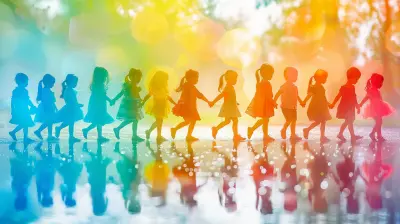8 April 2025
History often gets a bad rap for being dry and dull, but let’s be honest—it's anything but boring! History is packed with wild stories, fascinating characters, and lessons that still shape our world today. If you're homeschooling, you have a golden opportunity to make history come alive for your kids.
Forget monotonous textbooks and endless dates to memorize. Instead, let's talk about fun, interactive, and immersive ways to bring history lessons to life. Ready to take your homeschooling adventure to the next level? Let’s dive in!

Why Teach History Differently in Homeschooling?
Traditional schooling often reduces history to a memorization game, but that approach rarely sparks curiosity. Homeschooling gives you the freedom to make history engaging, relevant, and—most importantly—fun!When kids experience history as a thrilling story rather than a list of facts, they develop a deeper understanding and appreciation for it. Plus, hands-on learning helps them retain information better. After all, who wouldn't remember the American Revolution more vividly if they reenacted it in the backyard?

Engaging Ideas for Teaching History at Home

1. Use Historical Fiction and Literature
A textbook might give you the facts, but a well-written novel can place you right in the middle of history. Books like Number the Stars (World War II) or Johnny Tremain (American Revolution) provide historical context while making events feel real and personal.Encourage your child to read stories from different time periods, then discuss how real history influenced the characters' lives. Bonus points if you integrate audiobooks or dramatized readings for an added storytelling effect!
2. Time Travel Through Movies and Documentaries
Modern technology gives us access to incredible visual storytelling. Documentaries and historical movies allow kids to experience different eras in ways that textbooks simply can't.Some great picks include:
- Liberty’s Kids (American History for younger audiences)
- The Crown (for older students studying British history)
- Apollo 13 (for an engaging look at space exploration)
Just make sure to discuss accuracy—Hollywood loves taking creative liberties!
3. Visit Museums and Historic Sites
Nothing beats seeing history up close! If you live near a historic site or museum, make it a field trip. Many museums offer interactive exhibits and reenactments that make history feel real.Can’t visit in person? No problem! Virtual museum tours allow you to explore places like the Louvre, the Smithsonian, or the British Museum right from your living room.
4. Act It Out with Living History Reenactments
Who says learning history has to be passive? Get your kids involved in reenactments! Dressing up in period costumes and acting out historical events can make history unforgettable.- Reenact the signing of the Declaration of Independence.
- Have a "Medieval Feast" day.
- Stage a mock debate as historical figures.
By stepping into the shoes of historical characters, children develop empathy and a deeper appreciation for different perspectives.
5. Create a History Lapbook or Interactive Notebook
For kids who love arts and crafts, a history lapbook is a fantastic way to reinforce learning. These are creative, hands-on notebooks where students can compile key historical facts, timelines, and artwork.Encourage them to make mini-books, draw maps, or even create foldable diagrams of historical events. It’s a great way to make history more interactive and dynamic.
6. Cook Historical Recipes
Want to make history truly come alive? Cook meals from different time periods! Each dish tells a story about the culture and daily life of people from the past.- Try baking medieval bread.
- Make Civil War-era hardtack.
- Cook a dish popular in Ancient Rome.
Not only does this provide a sensory experience, but it also offers a delicious way to connect with the past.
7. Map It Out with Geography Connections
History and geography go hand in hand. Understanding where historical events took place helps kids see the bigger picture.- Use maps to track explorers' journeys.
- Create a timeline on a world map.
- Compare ancient vs. modern borders.
This visual connection can make historical events feel less abstract and more tangible.
8. Play History-Themed Board Games
Games make learning fun, and thankfully, there are some excellent history-themed board games available:- Timeline (A fast-paced game about placing events in order)
- 7 Wonders (Great for learning about ancient civilizations)
- Risk (Teaches strategy and historical warfare concepts)
Using games to reinforce historical events keeps lessons engaging and interactive!
9. Encourage Creative Writing with Historical Perspectives
A great way to engage students is by having them step into history through their own writing.- Have them write journal entries as if they were someone in the past (e.g., a soldier in the Civil War or a settler during the Oregon Trail).
- Ask them to write letters between historical figures.
- Challenge them to write their own historical fiction short stories.
Writing from a historical perspective builds critical thinking and creativity, all while reinforcing historical knowledge.
10. Interview Older Relatives About Their Experiences
History isn't just about famous figures—family history matters too! Encourage kids to interview grandparents or older relatives about their past.- What was life like when they were kids?
- Were there any major historical events they remember?
Connecting personal family history to broader historical events can make history feel more personal and meaningful.

Final Thoughts
History doesn’t have to be a monotonous recitation of dates and names. When homeschooling, you can turn it into a grand adventure filled with stories, reenactments, and hands-on activities. The goal isn’t just to teach history—it’s to help kids experience it.By making history interactive, personal, and engaging, you're not just helping your kids learn—you’re igniting their curiosity and love of learning. And who knows? Maybe you'll find yourself falling in love with history all over again too!






Isla Myers
Great insights for homeschool history!
April 17, 2025 at 7:39 PM